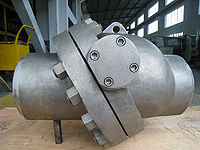
Photo from wikipedia
Phase-locked particle imaging velocimetry measurements are carried out in a direct-injected spark-ignition single-cylinder optical research engine equipped with fully variable valve timing to assess the impact of asymmetric intake valve… Click to show full abstract
Phase-locked particle imaging velocimetry measurements are carried out in a direct-injected spark-ignition single-cylinder optical research engine equipped with fully variable valve timing to assess the impact of asymmetric intake valve lift strategies on the in-cylinder flow. The engine was operated under a range of asymmetric strategies, with one valve following a full lift profile, while the second intake valve is scaled as a factor of the first, expressed as % maximum valve lift. Proper orthogonal decomposition combined with a proposed methodology allows instantaneous velocity fields to be decomposed into what are nominally demonstrated as coherent and turbulent constituent velocity fields. Analysis of the coherent fields reveals the behaviour of large-scale structures within the flow, subject to cyclic variation. In the case of 40% maximum valve lift, an increase in the flow cyclic variability is observed. This is found to be as a result of a switch between a flow dominated by a counter-rotating vortex pair and a single vortex. The impact of maximum valve lift on the bulk motion is further evident by an increase in the magnitude of swirl ratio from 0.5 to −6.0 (at 75°CA). Analysis of the turbulent constituent shows how the increased valve life asymmetry leads to increased turbulence during the intake stroke by over 250%. Finally, it is shown how the ensemble turbulence statistics may be misleading as stochastic fluctuations were found to be typically 66% of the total turbulent kinetic energy calculated from the ensemble statistic in the tested conditions.
Journal Title: International Journal of Engine Research
Year Published: 2018
Link to full text (if available)
Share on Social Media: Sign Up to like & get
recommendations!